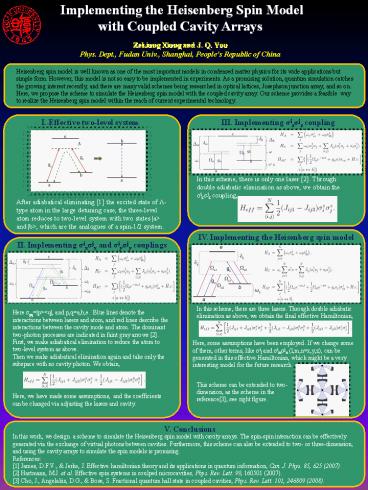Implementing the Heisenberg Spin Model - PowerPoint PPT Presentation
Title:
Implementing the Heisenberg Spin Model
Description:
... catches the growing interest recently, and there are many valid schemes being researched in optical lattices, Josephson junction array, and so on. – PowerPoint PPT presentation
Number of Views:58
Avg rating:3.0/5.0
Title: Implementing the Heisenberg Spin Model
1
Implementing the Heisenberg Spin Model with
Coupled Cavity Arrays ZeLiang Xiang and J. Q.
You Phys. Dept., Fudan Univ., Shanghai, Peoples
Republic of China
Heisenberg spin model is well known as one of the
most important models in condensed matter physics
for its wide applications but simple form.
However, this model is not so easy to be
implemented in experiments. As a promising
solution, quantum simulation catches the growing
interest recently, and there are many valid
schemes being researched in optical lattices,
Josephson junction array, and so on. Here, we
propose the scheme to simulate the Heisenberg
spin model with the coupled cavity array. Our
scheme provides a feasible way to realize the
Heisenberg spin model within the reach of current
experimental technology.
I. Effective two-level system
III. Implementing sizsjz coupling
In this scheme, there is only one laser 2.
Through double adiabatic elimination as above, we
obtain the sizsjz coupling,
After adiabatical eliminating 1 the excited
state of ?-type atom in the large detuning case,
the three-level atom reduces to two-level system
with two states agt and bgt, which are the
analogues of a spin-1/2 system.
IV. Implementing the Heisenberg spin model
II. Implementing sixsjx and siysjy couplings
In this scheme, there are three lasers. Through
double adiabatic elimination as above, we obtain
the final effective Hamiltonian,
Here spqpgtltq, and p,qa,b,e. Blue lines
denote the interactions between lasers and atom,
and red lines describe the interactions between
the cavity mode and atom. The dominant two-photon
processes are indicated in faint gray arrows
2. First, we make adiabatical elimination to
reduce the atom to two-level system as above.
Then we make adiabatical elimination again and
take only the subspace with no cavity photon. We
obtain,
Here, some assumptions have been employed. If we
change some of them, other terms, like sil and
simsjn (l,m,nx,y,z), can be generated in this
effective Hamiltonian, which might be a very
interesting model for the future research.
This scheme can be extended to two-dimension, as
the scheme in the reference3, see right figure.
Here, we have made some assumptions, and the
coefficients can be changed via adjusting the
lasers and cavity.
V. Conclusions
In this work, we design a scheme to simulate the
Heisenberg spin model with cavity arrays. The
spin-spin interaction can be effectively
generated via the exchange of virtual photons
between cavities. Furthermore, this scheme can
also be extended to two- or three-dimension, and
using the cavity arrays to simulate the spin
models is promising. References 1 James,
D.F.V., Jerke, J. Effective hamiltonian theory
and its applications in quantum information, Can.
J. Phys. 85, 625 (2007) 2 Hartmann, M.J. et al.
Effective spin systems in coulped microcavities,
Phys. Rev. Lett. 99, 160501 (2007). 3 Cho, J.,
Angelakis, D.G., Bose, S. Fractional quantum
hall state in coupled cavities, Phys. Rev. Lett.
101, 246809 (2008).































